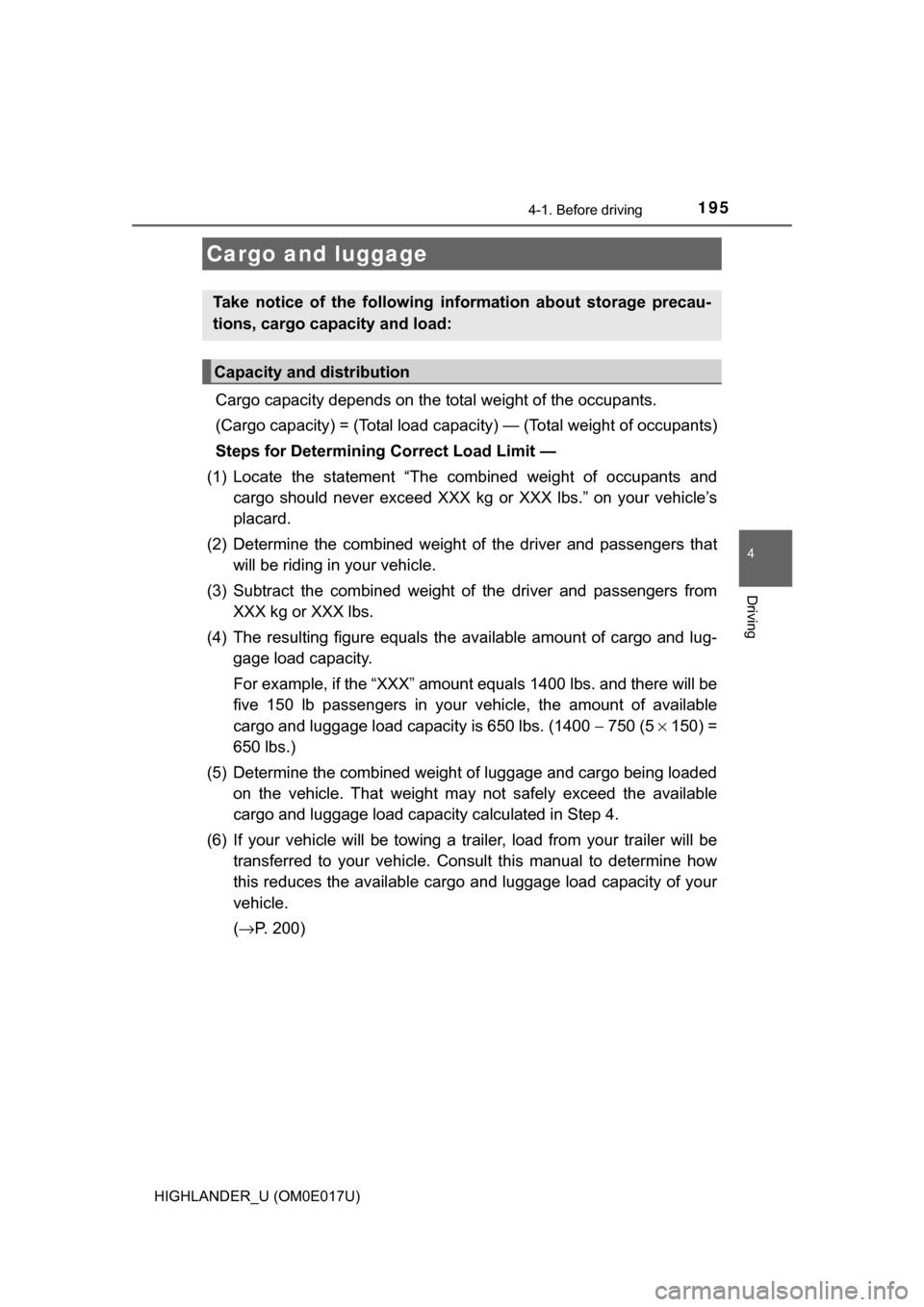Page 3 of 732

3
1
8 7
6
5
4
3
2
9
HIGHLANDER_U (OM0E017U)
10
4-1. Before drivingDriving the vehicle ............. 186
Cargo and luggage............ 195
Vehicle load limits ............. 200
Trailer towing..................... 201
Dinghy towing.................... 217
4-2. Driving procedures Engine (ignition) switch (vehicles without a
smart key system) ........... 218
Engine (ignition) switch (vehicles with a smart
key system) ..................... 221
Automatic transmission .................... 227
Turn signal lever................ 233
Parking brake .................... 234
4-3. Operating the lights and wipers
Headlight switch ................ 235
Automatic High Beam ....... 239
Fog light switch ................. 243
Windshield wipers and washer ............................ 244
Rear window wiper and washer ............................ 248
4-4. Refueling Opening the fuel tank cap .......................... 250 4-5. Using the driving
support systems
Toyota Safety Sense P ........................... 254
PCS (Pre-Collision System) ........................... 261
LDA (Lane Departure Alert with steering
control) ............................ 275
Dynamic radar cruise control.............................. 285
Stop & Start system ........... 297
Rear view monitor system ............................. 307
BSM (Blind Spot Monitor)......... 316
• BSM function ................. 321
• RCTA function ............... 324
All-wheel drive lock switch .............................. 330
Driving assist systems ........................... 331
Downhill assist control system ............................. 337
4-6. Driving tips Winter driving tips .............. 339
Utility vehicle precautions ...................... 343
4Driving
Page 16 of 732

16Pictorial index
HIGHLANDER_U (OM0E017U)
■Instrument panel
Engine switch . . . . . . . . . . . . . . . . . . . . . . . . . . . . . . . . . P. 218, 221
Starting the engine/changing the modes . . . . . . . . . . . . . P. 218, 221
Emergency stop of the engine . . . . . . . . . . . . . . . . . . . . . . . . . P. 573
When the engine will not start . . . . . . . . . . . . . . . . . . . . . . . . . P. 633
Warning messages
*1. . . . . . . . . . . . . . . . . . . . . . . . . . . . . . . . P. 604
Shift lever . . . . . . . . . . . . . . . . . . . . . . . . . . . . . . . . . . . . . . . . P. 227
Changing the shift position . . . . . . . . . . . . . . . . . . . . . . . . . . . P. 227
Precautions against towing . . . . . . . . . . . . . . . . . . . . . . . . . . . P. 575
When the shift lever does not move . . . . . . . . . . . . . . . . . . . . P. 231
Meters . . . . . . . . . . . . . . . . . . . . . . . . . . . . . . . . . . . . . . . . . . . . P. 92
Reading the meters/adjusting the meter light . . . . . . . . . . . . . . P. 92
Warning lights/indicator lights . . . . . . . . . . . . . . . . . . . . . . . . . . P. 86
When the warning lights come on . . . . . . . . . . . . . . . . . . . . . . P. 581
Multi-information display . . . . . . . . . . . . . . . . . . . . . . . . . . . . P. 95
Display . . . . . . . . . . . . . . . . . . . . . . . . . . . . . . . . . . . . . . . . . . . . P. 95
When a warning message or indicator is displayed . . . . . . . . . P. 591
1
2
3
Page 32 of 732
321-1. For safe use
HIGHLANDER_U (OM0E017U)
To release plate “B”, press the
release button on buckle “B”.
To release plate “A”, insert the
key (→P. 108) or plate “B” into
the hole on buckle “A”.
Retract the belt slowly when
releasing and stowing the seat
belt.
Holding plate “A” and “B”
together, insert both plates into
the holder on the roof.
Releasing and stowing the seat belt (for the third center seat)
Release button
Plate “B”
Buckle “B”
1
Buckle “A”
Buckle “A”Plate “B”
Plate “A”
Plate “A”
2
3
Page 185 of 732

185
4Driving
HIGHLANDER_U (OM0E017U)4-1. Before driving
Driving the vehicle ............. 186
Cargo and luggage ........... 195
Vehicle load limits ............. 200
Trailer towing..................... 201
Dinghy towing ................... 217
4-2. Driving procedures Engine (ignition) switch (vehicles without a
smart key system) ........... 218
Engine (ignition) switch (vehicles with a smart
key system) ..................... 221
Automatic transmission ..... 227
Turn signal lever................ 233
Parking brake .................... 234
4-3. Operating the lights and wipers
Headlight switch ................ 235
Automatic High Beam............................... 239
Fog light switch ................. 243
Windshield wipers and washer ..................... 244
Rear window wiper and washer ..................... 248 4-4. Refueling
Opening the fuel tank cap .......................... 250
4-5. Using the driving support systems
Toyota Safety Sense P .......................... 254
PCS (Pre-Collision System)........................... 261
LDA (Lane Departure Alert with steering
control) ............................ 275
Dynamic radar cruise control ............................. 285
Stop & Start system .......... 297
Rear view monitor system ............................ 307
BSM (Blind Spot Monitor) ........ 316
• BSM function ................ 321
• RCTA function .............. 324
All-wheel drive lock switch .............................. 330
Driving assist systems........................... 331
Downhill assist control system ............................ 337
4-6. Driving tips Winter driving tips ............. 339
Utility vehicle precautions ..................... 343
Page 195 of 732

1954-1. Before driving
4
Driving
HIGHLANDER_U (OM0E017U)
Cargo capacity depends on the total weight of the occupants.
(Cargo capacity) = (Total load capacity) — (Total weight of occupants)
Steps for Determining Correct Load Limit —
(1) Locate the statement “The comb ined weight of occupants and
cargo should never exceed XXX kg or XXX lbs.” on your vehicle’s
placard.
(2) Determine the combined weight of the driver and passengers that
will be riding in your vehicle.
(3) Subtract the combined weight of the driver and passengers from
XXX kg or XXX lbs.
(4) The resulting figure equals the available amount of cargo and lug- gage load capacity.
For example, if the “ XXX” amount equals 1400 lbs. and there will be
five 150 lb passengers in your v ehicle, the amount of available
cargo and luggage load capacity is 650 lbs. (1400 − 750 (5 × 150) =
650 lbs.)
(5) Determine the combined weight of luggage and cargo being loaded on the vehicle. That weight ma y not safely exceed the available
cargo and luggage load capacity calculated in Step 4.
(6) If your vehicle will be towing a tr ailer, load from your trailer will be
transferred to your vehicle. Consult this manual to determine how
this reduces the available cargo and luggage load capacity of your
vehicle.
( → P. 200)
Cargo and luggage
Take notice of the following information about storage precau-
tions, cargo capacity and load:
Capacity and distribution
Page 201 of 732

2014-1. Before driving
4
Driving
HIGHLANDER_U (OM0E017U)
Contact your Toyota dealer for further information about additional
requirements such as a towing kit, etc.
Trailer towing
Your vehicle is designed primarily as a passenger-and-load-car-
rying vehicle. Towing a trailer can have an adverse impact on
handling, performance, braking, durability, and fuel consump-
tion. For your safety and the safe ty of others, you must not over-
load your vehicle or trailer. You must also ensure that you are
using appropriate towing equipmen t, that the towing equipment
has been installed correctly an d used properly, and that you
employ the requisite driving habits.
Vehicle-trailer stability and braking performance are affected by
trailer stability, brake performance and setting, trailer brakes,
the hitch and hitch systems (if equipped).
To tow a trailer safely, use extreme care and drive the vehicle in
accordance with your trailer’s characteristics and operating
conditions.
Toyota warranties do not appl y to damage or malfunction
caused by towing a trailer for commercial purposes.
Page 202 of 732
2024-1. Before driving
HIGHLANDER_U (OM0E017U)■
GCWR (Gross Combination Weight Rating)
The maximum allowable gross
combination weight. The gross
combination weight is the sum
of the total vehicle weight
(including the occupants, cargo
and any optional equipment
installed on the vehicle) and the
weight of the trailer being towed
(including the cargo in the
trailer).
■GVWR (Gross Vehicl
e Weight Rating)
The maximum allowable gross
vehicle weight. The gross vehi-
cle weight is the total weight of
the vehicle. When towing a
trailer, it is the sum of the vehi-
cle weight (including the occu-
pants, cargo and any optional
equipment installed on the vehi-
cle) and the tongue weight.
Towing related terms
Page 203 of 732
2034-1. Before driving
4
Driving
HIGHLANDER_U (OM0E017U)■
GAWR (Gross Axle
Weight Rating)
The maximum allowable gross
axle weight. The gross axle
weight is the load placed on
each axle (front and rear).
■TWR (Trailer Weight Rating)
The maximum allowable gross
trailer weight. The gross trailer
weight is the sum of the trailer
weight and the weight of the
cargo in the trailer.
TWR is calculated assuming
base vehicle with one driver,
one front passenger, towing
package (if available), hitch and
hitch systems (if required).
Additional optional equipment, passengers and cargo in the vehicle will
reduce the trailer weight rating so as not to exceed GCWR, GVWR and
GAWR.
If the gross trailer weight exceeds 3000 lb. (1360 kg), it is recommended
to use a trailer with 2 or more axles.
Front GAWR
Rear GAWR
(With brakes)